Vi, Standish and Hugh M-P
Vi, Stan and Hugh, along with their eldest brother the 2nd Thomas Lodge Murray-Prior (b. 1912, see separate sidebar entry), were the children of Thomas B. and Lizzie M-P.
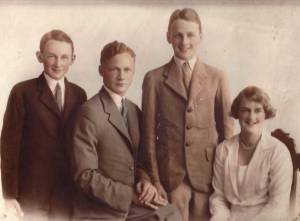 Siblings Hugh, Thomas L., Standish and Violet M-P: all served during World War II.1)
Siblings Hugh, Thomas L., Standish and Violet M-P: all served during World War II.1)
The three younger siblings: Stan, Vi and Hugh, probably at Maroon.2):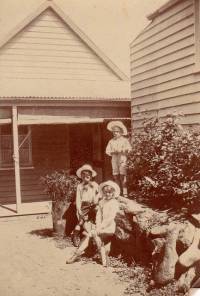
1. Minnie Violet (Vi) M-P (26 June 19133) - 27 June 19924). She was known to her immediate family as Vi and to the rest of the family as Aunt Vi. She was born at Highlands, the home of her grandparents in Sandgate Road, Albion (an inner suburb of Brisbane).
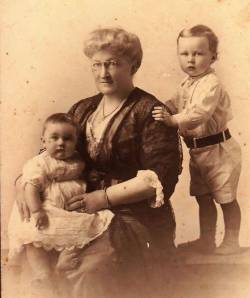 Minnie Lightoller with her grandchildren Vi and Thomas M-P, c.1914.5)
Minnie Lightoller with her grandchildren Vi and Thomas M-P, c.1914.5)
Vi's early life was similar to that of her brothers. She lived on the family’s last remaining cattle property, Maroon, until she was 6 or 7. After they left Maroon, the family lived for a short time in Southport, then moved out of Queensland to Birrilli, at Leura in the Blue Mountains of NSW. During 1927-30, from the age of 13 and by now living in Leura, Vi was a boarder at the MLC School in Burwood, Sydney. She was captain of the school’s 2nd B Tennis team. Tennis was also very much a part of the social life at Birrilli, which had its own tennis court. In her school holidays, tennis parties at home were very common with her brothers who, being boarders at The King’s School in Sydney, would bring home friends for holidays and occasional weekends. Of all the sports that she played, tennis was the one sport that she enjoyed and played all her life.
Vi shared the M-P love of horses, owing many in her lifetime. She thoroughly enjoyed horse riding for a large part of her life. As she had grown up riding horses at a very young age at Maroon, she was an excellent rider. Vi was a keen sportswoman up until the last few years of her life, also enjoying golf, surfing, gardening and fishing.
Vi’s very social life at ‘Birrilli’, plus frequent Sydney trips to visit friends, changed with the outbreak of World War II in 1939. In 1941, her brother Tom L2, his wife Lillian and their baby Tom A., moved to live with Vi and her parents for the duration of the war. In 1942, Vi joined the Australian Women's Land Army. 6) 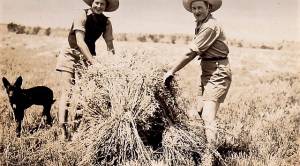
Vi (right) with a friend when working for the Australian Women's Land Army, 1943.
After the War ended, around late 1946/1947 when her parents separated and “Birrilli“ was sold, Vi, her mother and brother Tom L2, returned to Southport. After her mother died there in 1949, Vi very astutely used her inheritance to buy shares and a very large, traditional Queensland home (high on stilts, to catch the breeze). It was on two very large blocks of land on top of a hill in Muir Street. This house had magnificent views out to sea and, most importantly, had very high ceilings which allowed the display of many family inherited paintings, swords, furniture etc. which her brother, Tom L2, had asked Vi to look after, plus her own inheritances. Muir St. became the base of Vi’s active involvement and support of her two brothers who had children. Whenever they asked for help, for example due to sickness, Vi would drop everything to go and assist.
Muir St also became the holiday destination for Tom A. and Richard M-P as they were growing up. Also, Mary and John McClymont spent many holidays there as well. They were the children of Minnie McClymont (Aunt Min), who was Vi’s widowed cousin on her mother’s side and very dear friend. The McClymonts lived in the Brisbane suburb of Toowong.
While they were all in junior school, Tom A., Richard, John and Mary McClymont spent many wonderful holidays together at Currigee on South Stradbroke Island along with Vi and Minnie McClymont in a very small, fibro hut, The Peanut. Minnie’s father had, in earlier times, built, owned and occasionally stayed at there because he held many oyster leases in this then-remote area. The Peanut was aptly named as it contained two rooms, small front and rear verandahs, a wood stove, kerosene lamps (no electricity), a table and chairs, beds, a water tank (no running water) and an outside dunny. While fishing with the extended family on these holidays, Vi was a very patient and understanding expert/martyr in untangling hand-held fishing lines for the young people. Great times and experiences were had by all - though one time the adults' experience was memorable but not so wonderful - click on whiskey.
Tom A., in senior school, boarded in Toowong, Brisbane, and Vi would drive up from Southport in her small VW to attend many of his boarding school events, especially the sporting events. She became Aunt Vi to several of the other students.
Vi sold her Southport house in the late 1960s, and moved to Graceville in Brisbane, close to Tom A.’s family in the nearby suburb of Corinda. Vi was a great help to the family and, on the weekly car trip to the local shop for ice-creams, the four young children would eat them sitting on the back seat or standing in the small area behind the back seat (no seat belts then). When they had finished their ice-creams, Aunt Vi would apparently (so their parents belated learned) let some of the children ride on the running boards of her then slow moving, small VW beetle around the large grassed grounds and paddocks around their home. Ice cream excursions were exciting!
At various times, family members resided with Vi at Graceville. Julie Gillman (neé M-P) stayed with her while she undertook tertiary studies. John McClymont stayed with her after the Vietnam War as his mother, Minnie, had died while he was in Vietnam.
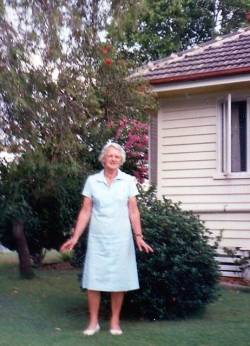 Vi outside her home Graceville.7)
Vi outside her home Graceville.7)
Vi’s other interests include the various dogs she owned in her life. Her South Stradbroke Island experience didn't stop her habit of enjoying a good whisky and a plain Capstan cigarette every night before dinner. These activities were a then common M-P family, before-dinner trait.
Vi never married. She had serious romances and thoughts of marriage, but the stumbling block was religion. At the time, it was difficult for practising Protestants to marry practising Catholics, and vice versa - and especially hard to resolve the issue in which faith any children would be raised. Religious bigotry (by modern standards) or religious conventions (by past standards) meant that it was instilled in family members that no Murray-Prior, of the Church of England faith, could marry a Roman Catholic. It was a very strong and long-held view, probably reinforced by the family's Irish roots. As in many families on both sides of the religious divide, there was also the threat of disinheritance and ostracism. Vi had several very serious romances, but the men were all Catholics. Such were the times.
By May 1992, Vi had suffered several small strokes (TIAs) in her home at Graceville. Consequently, she was moved to Coffs Harbour where she lived with and was cared for by her nephew and his wife, Tom A. and Theresa M-P. Vi, aged 79, suffered a massive stroke and died very soon after, on 27 June 1992 in the Coffs Harbour Base Hospital. Her extended family held a wake and service in Coffs, then a memorial service at the Church of England in Graceville. Her ashes were distributed by her immediate family at Maroon, the cattle property near Beaudesert in Queensland where she had spent the first years of her life.
Vi was a person of strong character and values. She could be very blunt and would forcibly tell anybody in the family if she thought they had deviated from her values. Equally, she was very caring and thoughtful with a delightful sense of humour and often a ‘twinkle’ in her eyes. Her deep love for her family, in later life especially her nephews and nieces, was reciprocated. You need someone like Vi in every family.
For more photos of Vi, click on Vi Photos
2. Standish (Stan) Haly M-P (13 February 1915-1 August 1994) was born in Brisbane. Stan, or Narn as he was known by the family, attended school at Southport then, when family moved to NSW, Leura Public School. He attended The Kings School at Parramatta from 1926-33. At Kings he was a keen sportsman, representing the school in athletics, rugby and rowing.8) After leaving school it is thought that he moved to north Queensland where he was involved in tobacco farming with his brother Tom west of Dimbulah and in sugar cane work for the Munro Estate at Pawngilly, south of Cairns.
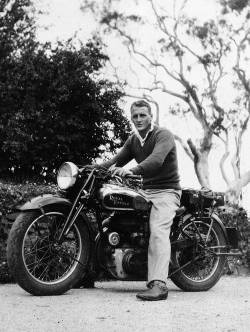 Stan on his motorbike, probably before the War.
Stan on his motorbike, probably before the War.
When World War II broke out, he attempted to join the Royal Australian Air Force but was rejected due to colour blindness. On 8 May 1940 he enlisted in the 2/1st Australian Anti-Aircraft Regiment. On enlisting he gave his occupation as 'sugar cane student' and that he had military experience with the Kings School cadets.9)
Stan's unit embarked on the Orcades from Port Tewfik, Egypt as part of the force code named as 'Stepsister', which was the subject of heated arguments between Churchill and Curtin about the deployment of Australian forces returning from the Middle East.10) Eventually Curtin won the argument and the Orcades was tasked to offload troops to defend Indonesia. The Orcades was off the southern tip of Sumatra on Friday 13 February 1942 (Stan's 27th birthday) without sighting or being attacked by Japanese planes. On the 15th, units including two troops of the 2/1st Light AA, one of which was Stan’s, were disembarked via a small coastal vessel and landed at Telukbetung (now called Bandar Lampung) in southern Sumatra. They were tasked to defend the airfield at Palembang (some 500 km by rail) north of the port. Fortunately they were notified that evening that the airfield had already been captured and were extremely lucky to be able to reboard the Orcades (which had seen their Aldis lamp signals and so had not left) on the morning of the 16th. They reached Batavia (now Jakarta) on 17th, where units began disembarking for the defence of Java. Once again, luckily for Stan's regiment, as they began disembarking on the 19th, they were notified to stay aboard; they later learned that Darwin had been bombed that day and their unit was needed to provide air defence for Darwin.To avoid Japanese submarines, the Orcades took Stan and his unit down the Western Australian coast and across the Great Australian Bight; they disembarked in Adelaide. After time at Darwin and the Atherton Tablelands, his unit was involved in the invasion of Borneo, landing at Balikpapan in what is now East (Kalimantan). At that time, Stan held the rank of Warrant Officer (Class 2). He was demobilised on 14 January 1946.
Stan returned to far north Queensland, where he was thought to have bought a corner store in Bunda Street, Cairns. His children recall him talking about the people coming in to buy their packet of Bex every day: [given it caused kidney failure], that was why he would never allow 'headache' powders in the house. Facing competition from Coles and disillusioned by dishonest customers, he sold the shop and, it is thought, moved to Munro Estate to work with Richard Percival (Percy) Rudkin (a former Sergeant in the 5th Light Horse), who introduced him to his niece, Betty Rudkin. Betty's father was Thomas Sidney (Sid) Rudkin, 3rd Battalion, 1st AIF and later manager of Nyngan and Temora Agricultural Farms for the NSW Department of Agriculture. It appears that Betty's father, Sid, may have met Stan's father, Thomas Bertram M-P, as Betty remembers her father telling the family he met a man with one eye who was riding a horse, while they were holidaying in Leura. Stan purchased a cane farm on the north-eastern bank of the Josephine Creek bridge, Pawngilly (near Innisfail). He and Betty were married in a small ceremony at St Albans Anglican Church, Innisfail on 1 December 1951. Later they purchased another farm, diagonally across, on the south-western bank of the Josephine. They sold the farms in 1973 and moved to Pin Gin Hill outside of Innisfail, where Stan had various jobs until he died in a level crossing smash with a cane train outside of Innisfail on the 1 August 1994. Betty later moved to Cairns, staying at Heritage Gardens Retirement Village in Earlville, Cairns before moving to Farnorah Residential Aged Care, Cairns. She died on 28 May 2017 in Cairns Hospital following an operation to mend a fractured femur. Stan was an active member of the local Babinda and Bartle Frere community. He was a foundation member of the Babinda RSL, the Babinda Memorial Hall Committee and the Babinda Show Association, all of which involved active participation of RSL members. He held various executive roles in all these and was also an active member of Legacy.
Stan and Betty had a son and daughter both of whom married; the latter has three children. His daughter-in-law’s parents had experience in war that echoed much of Stan’s. William (Bill) O'Connor enlisted in the 2/2 Heavy Anti-Aircraft Regiment and Ellen O’Connor (nee Woods) in the 2/2nd Australian General Hospital, with both serving in the Middle East. In a twist of fate, Ellen was also in the 'Stepsister' force, travelling back from the Middle East. Her unit was offloaded in Java, only to be re-embarked and returned to Australia because their transport ship (to move the hospital) had been captured.
For more photos of Stan and his family, click on Stan.
3. Hugh Burnett M-P, born 22 July 1916 at Boonah, Queensland; died 15 November 1984.11) He contacted polio when young which affected a leg. His eulogy suggested that the family were advised to move from Queensland to a cooler climate, i.e. Leura.12) Like his brother, he went to King's School, leaving in 1935.13) As with all his siblings, and despite his polio legacy, Hugh was a capable sportsman.14) In adult life, he was a very good golfer and is remembered as having owned a racehorse.15) Hugh was a very social man, and a photograph in the Sydney Morning Herald shows him enjoying the opening night of one of Sydney's leading restaurants, Princes. He was shown with a future Prime Minister Gough Whitlam, a friend from university, and famed American violinist Guila Bustabo.16)
Hugh graduated from the University of Sydney with a MB,BS (Bachelor of Medicine, Bachelor of Surgery) in 1942, in the midst of World War II. While at Sydney University, he lived at St Paul's College.17) He enlisted as a medical officer in the army on 15 July 1943, serving until 29 July 1947 apparently mainly in Papua new Guinea. 18) After the War, he became a well-respected obstetrician/gynaecologist, from 1947 mainly working and living in Newcastle. He formed a partnership with Dr W. McLaughlin from 1948. He died aged 68 having suffered from serious illness for 'several years', including 'severe chest disease'.19)
On 5 October 1962, at the Kings School chapel, he married nurse Elizabeth Ann Harper (23 September 1935 - 5 March 2014)20); they had no children.21) After Hugh died, Elizabeth remarried, to Peter Clark. Again, there were no children of the marriage. She died in March 2014.22)
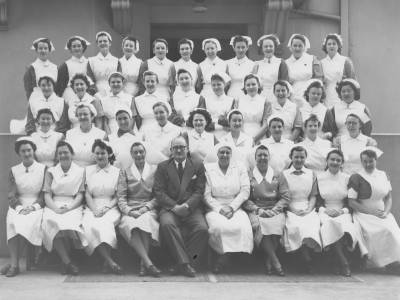 Dr Hugh M-P in 1952 when he was Medical Superintendent of Crown Street Women's Hospital.23) He is sitting next the legendary Matron Edna Shaw (in white) and with future Matrons Blair (right) and Love (left) as well as graduating midwives.24)
Dr Hugh M-P in 1952 when he was Medical Superintendent of Crown Street Women's Hospital.23) He is sitting next the legendary Matron Edna Shaw (in white) and with future Matrons Blair (right) and Love (left) as well as graduating midwives.24)
For more photos of Hugh M-P, click on Dr Hugh